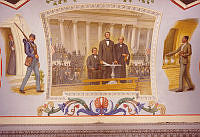Rubenstein Center Scholarship
Nancy Syphax – Life and Legacy
An Enslaved Resident of the Historic Decatur House
This article is part of the Slavery in the President’s Neighborhood initiative. Explore the Timeline
Nancy Syphax was a member of a prominent Washington, D.C. family that was considered to be among the “Black Elite” during the nineteenth century.1 Unfortunately, Nancy did not share the same status as most of her family. Instead, she worked as an enslaved house servant in the President’s Neighborhood at Decatur House for John Gadsby from at least 1836 until his death in May 1844. Most of her other family members in the District of Columbia were freed by 1837 through the efforts of her father William Syphax—however both she and her brother Charles remained enslaved until 1862. Charles Syphax was freed in December of that year through a deed signed by Robert E. Lee, executor of the estate of his late father-in-law, George Washington Parke Custis. Nancy was freed seven months earlier by the D.C. Compensated Emancipation Act of 1862, signed into law by President Abraham Lincoln.2

The condensed Syphax-Joseph family tree.
Stephen E. HammondBased on federal census records, Nancy’s year of birth has been estimated to be 1791. Other documents suggest that she may have been born as late as 1809 and died prior to 1880. Her burial location is yet to be discovered. Primary and secondary source documents, coupled with family folklore, offer enough information to reconstruct a narrative of Nancy’s life. She was the daughter of William Syphax, a well-known “character” who lived in Alexandria, Virginia. He was an itinerant preacher who traveled a great deal prophesizing and sharing his abolitionist views of slavery, while working to solicit donations and contributions to free his family.3 In addition to her brother, Nancy had several sisters who also were enslaved. William purchased his own freedom in 1817 with the help and support of local Quakers.4 For at least the next two decades, he worked to free members of his enslaved family. Although at least five of her younger sisters were purchased and freed by their father, William was unsuccessful in his attempts to free Nancy.5 One sister, Amelia, was born free:
“A colored man named William Syphax, … [is] now in this city [New York, NY], soliciting aid to purchase his two daughters now held in bondage in the District of Columbia. He has already purchased his own freedom at $333.33—his wife at $350: one daughter at $320—another at $275—another at $312—another at $110—another at $150. He wishes to raise about $600 more, which will liberate his whole family.”6
The sum of money that William Syphax raised in the early nineteenth century to purchase the freedom of six family members, as well as his own freedom, is not insignificant. This effort was an extraordinary one, especially for a man with modest means and limited earning potential like William. The $1,850 raised by William equates to nearly $48,000 in 2020.7
It is not certain how the life of Nancy Syphax became intertwined with that of John Gadsby and his family. Gadsby regularly bought and sold enslaved people to support his businesses in Alexandria, Baltimore, Maryland, and the District of Columbia. When and where he acquired Nancy is unknown, but the location of Gadsby’s Alexandria business perhaps reveals how they first met. Gadsby operated his popular tavern in Alexandria less than one city block away from where Nancy’s father, William, once lived. Based on the proximity of Gadsby’s tavern to William’s home in Alexandria, Nancy’s mother may have been one of Gadsby’s enslaved women or Gadsby may have acquired her through a business deal along the way. Gadsby left Alexandria for Baltimore around 1808. Nancy would have been about seventeen years old at the time, which was a prime age for young enslaved women to be working for a businessman slave owner. However, no definitive records have been discovered showing Nancy working in Gadsby’s home or businesses until 1844. Federal census records between 1820 and 1840 do show Gadsby owning a number of enslaved women whose ages correlate with Nancy’s at the time.

Circuit Court Emancipation Deed for William Syphax dated 21 November 1817, recorded 14 April 1831.
Stephen E. Hammond/Alexandria Circuit Court Records, 1785-1863Nancy Syphax is listed in the probate records of John Gadsby, who died on May 15, 1844. Her value is listed as $100.8 She was willed to his wife Providence (Provey). Nancy remained at Decatur House until Provey died in February 1858. Provey left Nancy to her daughter Augusta McBlair in her will with an estimated value of $100.9 In May 1862, McBlair filed a petition for compensation as an owner who voluntarily freed six enslaved persons: Henry King, Maria King, George King, Martha King, Maria Williams and Nancy Syphax.10 Here is how McBlair described Nancy in the petition:
“… about 5 feet 2 inches high, Yellow Complexion, Black eyes, grayish black hair, age 53 years & healthy … a good nurse, house servant and laundress and is worth $800.”
Nancy Syphax was one of 3,185 enslaved people freed as a result of the Emancipation Compensation Act. The commissioners, who were appointed to examine petitions and determine fair compensation for slave owners approved a payment to Augusta McBlair of $87.60 for the loss of Nancy Syphax’s services as an enslaved servant, an amount just slightly more than ten percent of her estimated value. Of course, Nancy received no compensation for the decades of enslavement that she endured. However, more than $1 million was distributed among about 960 District of Columbia petitioners for their “losses”. Ironically, the U.S. federal census of 1870 records Nancy in the household of Augusta McBlair and her husband John, indicating that even after Nancy received her freedom she continued to work in her former enslaver’s household.11
Prior to the Civil War, at least one of Nancy’s sisters and several nephews were living free in the District of Columbia. The most notable family member was William Syphax, son of Nancy’s brother Charles and his wife Maria (pronounced Mariah). He had taken a job at the Department of the Interior as a messenger some years earlier. In that role, he served under nine Interior Secretaries. He was a founder of the Social, Civil and Statistical Association, a black organization that worked to advance the cause of emancipation. William Syphax ultimately used his relationships with elected officials to successfully petition Congress in 1866 for the return of his mother’s seventeen-acre property located at the southern end of the Arlington plantation that was improperly seized by the Federal government in 1863. Nancy lived just a short distance away from her kinfolk: she lived on I Street NW, while other Syphax relatives resided on 16th and P Street NW. Nancy may have had some flexibility to come and go while she was enslaved, but after her emancipation she moved about the city and the White House neighborhood a bit more freely. She likely attended church with other family members and they probably celebrated her freedom in 1862, as well as other occasions such as weddings, births, and deaths.
Nancy had at least one child of her own, a daughter named Margaret, who was born about 1818. It must have been a heart-wrenching day when Margaret was separated from her mother and sold. She was likely sold between 1830 and 1838 (between age 12-20) in Washington, D.C. or Alexandria, and taken to New Orleans, Louisiana. There is no record of her sale in the North or the South after she arrived in New Orleans. She may have been forced to work in someone’s house, serve as a lady’s enslaved maid or caretaker for young children, or work as a ‘fancy girl’ serving male customers in a local brothel.12

The author holding the tintype photograph of Margaret Syphax (photograph taken by Matthew D'Agostino). Photograph of Margaret Syphax (the author's second great grandmother) courtesy of Roland Jefferson, second cousin to the author and grandson of Martha Joseph Spratlin. The location is likely New Orleans, date unknown.
Stephen E. HammondMargaret gave birth to a son named Peter Joseph in 1842. He is likely one of four grandchildren of Nancy Syphax. In the 1850s, while he was in his early teens, someone helped Peter write a letter to his grandmother because he could neither read nor write. The letter, transcribed below, is a family heirloom handed down through the generations.13 Peter described his life to Nancy and how much he looked forward to seeing her someday.
“Dear, graney, i, like, to, see, you, but, if, i, live, to 2, years, and, god, spar, mea, i, Will, come, and, see, you, i, Noe, very, Well, that, you, Will, be, hapey, to, see, your, grann, son, And, your, grann, Dauter, now, i, at, Risness, and, a, smarte, boy, i, Am, 13, years, of, age, and, my, sister, is, 15, years, of, age, 2, little, brother, 1, is, name, charles, he, is, 3, month, ole, and, a, nauther, name, William, and, My, self, onibul, gran, son, by, the, Name, of, P. Josephe and my sister, name, suminer, And, tell, all, my parants hardy may, leter, is, very, shorte, bute, ceuse , me, grann, muther, but, you, Will, be hapy, to, see, your, fine grann, son, by, the, name, P. Joseph, Zeb” [sic]
Margaret must have shared memories of her mother and Syphax family stories so Peter knew of his ‘people’ up North in the nation’s capital. Still enslaved herself, family tradition says that Margaret convinced an Austrian merchant by the name of Spaero Narravitch to purchase her young son’s freedom from her owner. Margaret bound Peter out to a mason to learn a trade once he was older. Meanwhile, she probably remained enslaved until the Emancipation Proclamation in 1863. Nancy may have outlived Margaret, who died in 1877. She would have been extremely proud of Margaret for her perseverance and personal sacrifice and the accomplishments of her grandson and his descendants. Nancy had no idea that one day her grandson Peter would help determine the resident of 1600 Pennsylvania Avenue in 1877.
Peter served in the Union Army as a teamster in Company A of the 92nd United States Colored Troops infantry, probably driving a wagon ferrying supplies and/or removing casualties of war from the battlefield. His service is honored at the African American Civil War Memorial on U Street in Washington, D.C. During the war, he learned to read and write. After the war, Peter became a member of the Metropolitan Police Force and he established and led several black militia groups, which marched in two inaugural parades in Washington, D.C. His service earned him the rank of Colonel, especially after he helped defend New Orleans against multiple attempted takeovers by the ‘White League.’ The White League was a white paramilitary terrorist group established in the 1870s to intimidate freedmen from voting and politically organizing. They were determined to reclaim the white rule, racism and terrorism that existed prior to the war.14

Peter Joseph and his family contributed to the legal defense fund which would ultimately litigate and test the constitutionality of the Separate Car Law.
New Orleans Times-Picayune, ca. 1890, newspaper article from scrapbook courtesy of Luana CarterIn 1876, Peter was elected as one of eight presidential electors from Louisiana for the presidential election between Rutherford B. Hayes and Samuel J. Tilden.15 During the campaign, he was offered a substantial bribe to cast his vote for Tilden. However, he rejected it in favor of the Republican candidate, Hayes.16 Peter’s Electoral College vote was one of twenty that determined the outcome of the highly contested election. Unbeknownst to Peter, Hayes’ election ultimately lead to the Compromise of 1877 and ended Reconstruction in the South.17 In the years that followed, many states passed laws that took away the rights of African Americans and deliberately separated the races. In 1880, Peter wrote a letter to President Hayes recommending his cousin, William Syphax of Washington, D.C., for an appointment in his administration.18
Peter also worked to combat racism through the court system. In 1873, he sued the Academy of Music in New Orleans for racial discrimination and won. The case was appealed by the defendant to the Louisiana Supreme Court in 1875 where the decision was reaffirmed. This case was one of several early cases leading up to the United States Supreme Court hearing the Plessy v. Ferguson case in 1896. Peter was an actively involved citizen fighting the ‘separate but equal’ laws that were established and enforced. Peter and each member of his young family contributed to the legal defense fund which would ultimately be used to help litigate and test the constitutionality of the Separate Car Law—and he challenged others in New Orleans to do the same.19
Gallery
-

Graduation photograph of Zipporah Marcella Joseph
The Statesman, June 1, 1901. -

A newspaper clipping about Zipporah Marcella Joseph's graduation.
The Statesman, June 1, 1901. -

A photograph of Joseph later in life.
The Statesman, June 1, 1901.
By 1890, Peter and his wife Cora were fed up with the segregationist laws that remained in effect in New Orleans. Although Governor Francis Nicholls had recently named Peter as a Trustee of Southern University, he made the difficult decision to move his family to Denver, Colorado, to seek better opportunities for his children. There also was an increasing demand for his masonry skills in the rapidly growing city. Peter and Cora understood the importance of receiving a formal education that had been denied to them, so then sent their children to other cities to receive a high-quality education. Their oldest daughter, Ellender, was sent from New Orleans to Washington, D.C. in the 1880s to live with cousin William Syphax in order to attend the Charles Sumner School.20 William served as the first president of the Board of Trustees of the Colored Public Schools of Washington, D.C. from July 1, 1868 to June 30, 1871, and oversaw the construction of the school at 17th and M Street NW and its opening in 1872.21 Ellender returned to New Orleans to attend college at Southern University, becoming the valedictorian of the very first graduating class in 1887.22

Photograph of Valurez B. Spratlin, PhD, courtesy of Royce Spratlin, second cousin to the author and great grandson of Martha Joseph Spratlin.
Stephen E. HammondWhen Peter and Cora moved to Denver in 1892, they left three of their seven children behind in New Orleans. All three became teachers after graduating at or near the top of their classes at Southern University. In Denver, their daughter Zipporah Joseph received national attention in dozens of black newspapers across the country when she became the first black valedictorian of a Denver public high school in 1901. Protests by teachers and students nearly forced the graduation commencement to be cancelled rather than allow Zipporah to be recognized for her achievement.23 Peter Joseph did not tolerate that disrespect. He ensured that his daughter was recognized for her outstanding academic achievements by pressing the leadership of the public school. Peter died in 1905 and is buried in the veterans’ section of historic Riverside Cemetery in Denver.

Photo of Colonel Edward Creston Gleed, courtesy of Carolyn Weaver, second cousin to the author and daughter of Col. Gleed.
Courtesy of Carolyn WeaverNancy Syphax would have been equally proud of her great-grandchildren for many of their accomplishments helped change the country. One great-grandson, Valurez B. Spratlin, PhD (1897-1961), earned his doctoral degree with honors in Modern Language from the prestigious language school, Middlebury College, in Vermont.24 In 1927, ‘Vaz’ was appointed acting Head and later permanent Head of the Romance Languages Department of Howard University in Washington, D.C. He taught at Howard for about thirty-five years. During that time, along with his teaching responsibilities, he developed general education courses in the humanities, while organizing and expanding the Department of Romance Languages. Another great-grandson, Edward Creston Gleed (1916-1990), served in the United States Air Force during World War II as a Tuskegee Airman in the famed 332 Fighter Group.25 The Tuskegee Airmen were the first black military aviators in the U.S. Army Air Corps (AAC), a precursor of the U.S. Air Force who trained at the Tuskegee Army Air Field in Alabama.26 His Group established a solid record of achievement. During the latter stages of WWII, the Group performed the important task of bomber escort in support of the Fifteenth Air Force. He took pride in the fact that his Group never lost a bomber to an enemy fighter. Years later, detailed analysis found that enemy aircraft actually shot down at least twenty-five bombers they escorted during nearly 200 missions. That record was a much better success rate than other escort groups of the 15th Air Force, which lost an average of 46 bombers. Gleed retired as a full Colonel. Another great-grandchild, Zipporah Joseph Parks (1924-2011), persevered through segregation and isolation to become the first black nurse to graduate from the University of Colorado at Boulder in 1946.27 She was a surgical-room nurse who helped provide care for infant polio patients at the acclaimed John A. Andrews Hospital on Tuskegee University’s, campus in Alabama. She is recognized at the Women in Military Service to America memorial at Arlington National Cemetery for her participation in the United States Cadet Nursing Corps.
Gallery
-

Photograph of Zipporah Joseph (Parks) Hammond. She is the author's mother.
Stephen E. Hammond -

Photograph of Zipporah Joseph (Parks) Hammond. She is the author's mother.
Stephen E. Hammond
All of these Nancy Syphax descendants fought the indignities, prejudices, and racism they encountered along the way. Each went on to create better lives and opportunities for those who have followed. Despite the indignities Nancy suffered as an enslaved woman within sight of the White House, despite the forced separation and sale of her daughter Margaret to slave traders, Nancy Syphax would be extremely proud of the legacy she left behind and the accomplishments of her descendants. The Syphax family has not only played an important role in local communities and civil rights, but family members have influenced United States presidential elections, national politics, federal law, and they have served in the military to protect our nation’s freedom and contributed to our nation’s story.
Stephen E. Hammond is a retired earth scientist who after a forty-year career with the U.S. Geological Survey traded geology for genealogy. He has been actively researching the Syphax family history for nearly fifty years. Nancy Syphax is the author’s third great grandmother.










